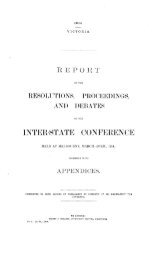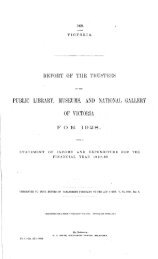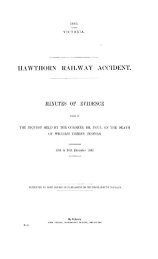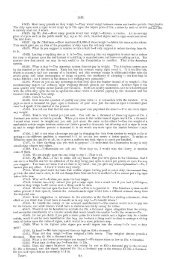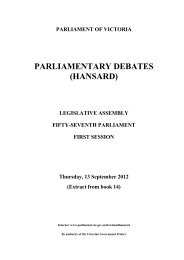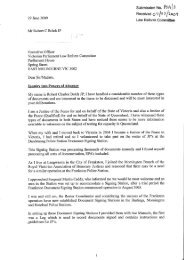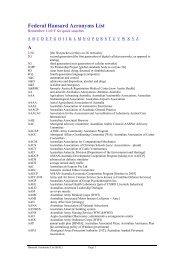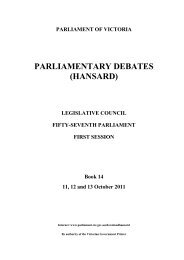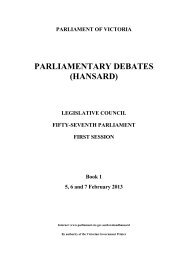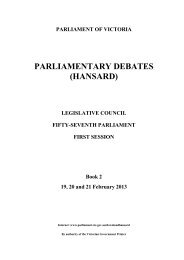Book 8 - Parliament of Victoria
Book 8 - Parliament of Victoria
Book 8 - Parliament of Victoria
Create successful ePaper yourself
Turn your PDF publications into a flip-book with our unique Google optimized e-Paper software.
FLOODS: WATER STORAGE MONITORING<br />
Wednesday, 1 June 2011 COUNCIL 1649<br />
direct conflict, suing each other or cost shifting to each<br />
other. One may be implementing a practice that causes<br />
direct loss to the other. They might be arguing over<br />
who is going to fix up a road. Never has it been the case<br />
that a council is required to vote in such a way that it<br />
will be consistent with state government policy. That<br />
adds a third plank to my level <strong>of</strong> concern about this<br />
particular government venture.<br />
Clearly government members are rattled for a reason. I<br />
am not suggesting it is an overreaction by<br />
inexperienced politicians; I am suggesting that<br />
government members do not like the impact that the<br />
ethical paper pledge is having out there on the market,<br />
which is at some sort <strong>of</strong> tipping point. Nobody wants to<br />
support the sort <strong>of</strong> destruction that you will see hidden<br />
in those valleys behind Healesville when you get <strong>of</strong>f the<br />
beaten track.<br />
The Minister for Agriculture and Food Security has<br />
responsibility for all those who want to grow trees on<br />
their own land at their own risk, as well as to their<br />
competitor, VicForests. I think the minister and the<br />
Deputy Premier have lost track <strong>of</strong> what they are here<br />
for. We will see more such overreactions and<br />
heavy-handedness not just in this one area but in any<br />
area that proves to be a sore point for the government at<br />
that particular time.<br />
Motion agreed to.<br />
FLOODS: WATER STORAGE<br />
MONITORING<br />
Mr BARBER (Northern Metropolitan) — I move:<br />
That this house requests the Minister for Water to conduct an<br />
urgent review <strong>of</strong> the operating rules for all major water<br />
storages so as to minimise potential flood risks on regulated<br />
rivers.<br />
I notice from the government press release that this<br />
week has been designated Flood Awareness Week,<br />
during which citizens are being given instructions on<br />
how they can help through their action to minimise<br />
their own flood risk. This motion asks the state<br />
government to take action in order to mitigate<br />
everybody’s flood risk in relation to regulated rivers.<br />
My rationale for this motion has arisen from the floods<br />
we experienced earlier this year. Some <strong>of</strong> those floods<br />
were the immediate result <strong>of</strong> flash flooding in<br />
unregulated rivers, but north <strong>of</strong> the Divide the worst<br />
devastation was seen on rivers which all have large<br />
dams at their headwaters and where the flow <strong>of</strong> those<br />
rivers has traditionally been strictly regulated.<br />
I am not pointing the finger at anybody with this<br />
motion. Of course we have just had a decade <strong>of</strong> drought<br />
during which nobody would have turned their mind to<br />
this. Over the past five years I have visited the area<br />
around Lake Eppalock several times. If I had been<br />
standing, as I was, at the bottom <strong>of</strong> Lake Eppalock<br />
when it was a dry dust bowl, it never would have<br />
occurred to me that our biggest risk coming down the<br />
line was going to be a flood from that dam onto the<br />
river and downstream communities. However, we have<br />
an opportunity to learn from this recent experience.<br />
With water storages being as full as they are around the<br />
state, it is urgent that we deal with this issue before the<br />
arrival <strong>of</strong> winter rains, spring rains or even the<br />
unseasonal summer rains that finally tipped the balance<br />
on the Lake Eppalock system.<br />
I attended one <strong>of</strong> the public meetings <strong>of</strong> the Comrie<br />
inquiry into the flood disaster in Rochester. At that<br />
meeting a member <strong>of</strong> the public stated that this was a<br />
man-made flood. I knew what he was referring to,<br />
because I had observed and tracked the extraordinary<br />
situation with Lake Eppalock, which had been all but<br />
empty for decades up until August last year. In the<br />
space <strong>of</strong> a week or so in September the lake had risen to<br />
two-thirds full, by December it was just below full and<br />
then became over-full and in fact extremely full in<br />
January, leading to the overtopping <strong>of</strong> the dam and<br />
floodwaters pouring down to Rochester. By one<br />
measure this was the largest flood we have on record —<br />
that is, from the public record <strong>of</strong> flow rates, which is<br />
still available on a departmental website going back to<br />
the 1970s. Prior to the 1990s there was a big flood<br />
every year — a big one in the 1970s, a big one in the<br />
1980s and a big one in the 1990s — there was nothing<br />
in the 2000s and then the biggest <strong>of</strong> all in terms <strong>of</strong> rates<br />
in January this year.<br />
Lake Eppalock is a significantly large storage which, as<br />
I said, filled up extraordinarily quickly — 300 gigalitres<br />
and beyond — as the water tried to crowd out over that<br />
spillway. Even though the dam was technically at a<br />
level <strong>of</strong> 100 per cent, another few metres <strong>of</strong> water<br />
standing over the spillway causes a backward pressure<br />
that fills the dam to an even greater level across its large<br />
surface area. Lake Eppalock has only a small regulated<br />
outlet which is used for irrigation releases <strong>of</strong><br />
1000 megalitres or so a day. There have been calls for<br />
that to be expanded to 10 000 gigalitres.<br />
Having studied the rates <strong>of</strong> inflow and outflow and<br />
storage at Lake Eppalock with data that is now<br />
available, it is clear to me that with a 10-gigalitre<br />
storage, with some degree <strong>of</strong> foresight and some<br />
different operating rules, the amplitude <strong>of</strong> this flood<br />
could have been reduced; there is no doubt about it.



